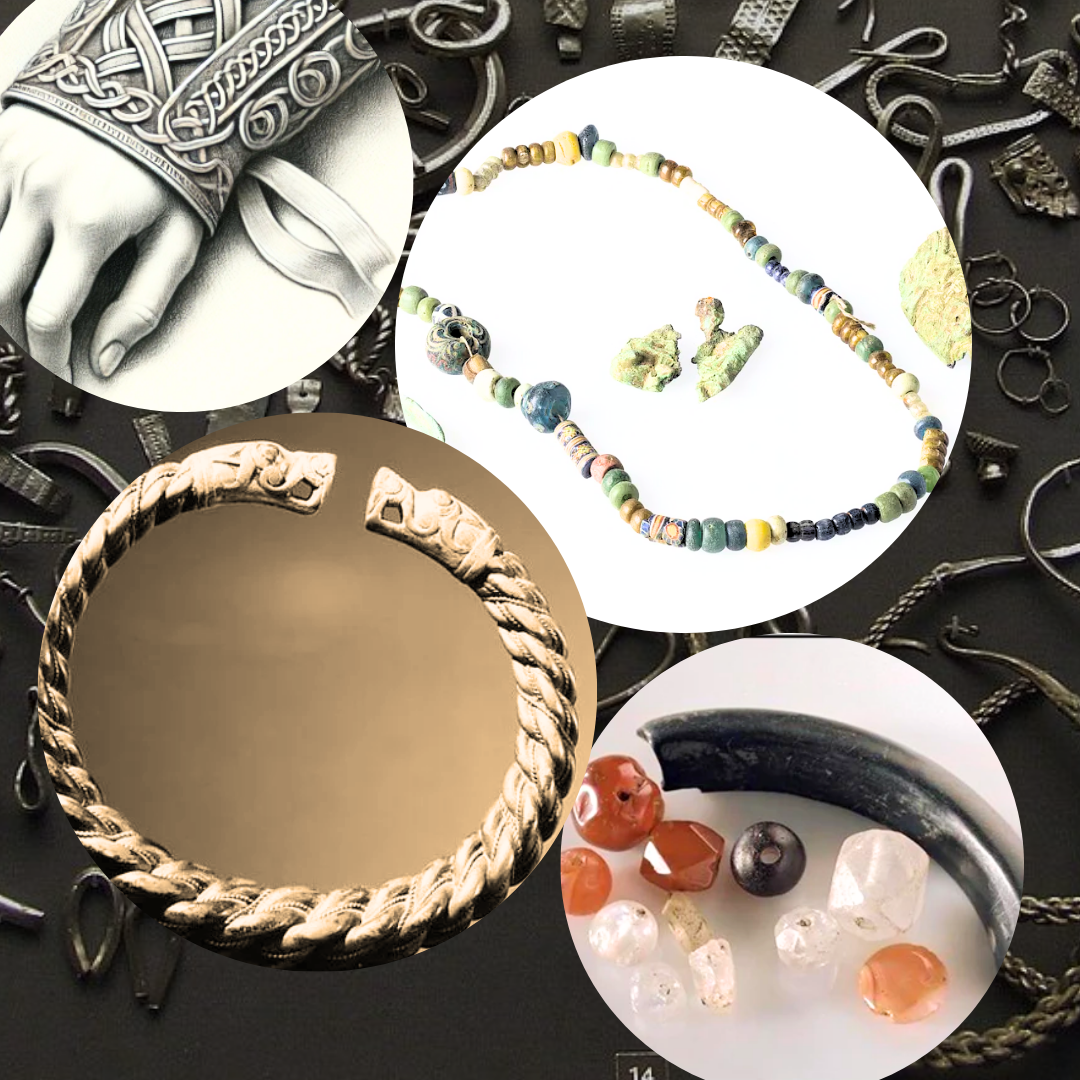
Norse Bracelets in Viking Age Archeology
Share
The Different Types of Norse Bracelets in the Viking Age
Bracelets are the most common jewelry found in the viking age archeology. However, although most are aware of the traditional metal viking arm rings, there were other types of bracelets that were worn such as glass beads, stones, crystals, clasps, sashes and other items. This article goes over the different types that have been found in the archeology.
Bracelets: The most common type of Viking Jewelry
As can be observed from the diagram, the arm bracelets are by far the most
numerous category of artifacts included in the study by Daniel Gunnarsson in his Thesis The distribution of Bronze artefacts of Viking Age Eastern Baltic types
discovered on Gotland. Read his full theseis here. Although this article uncovered the quantities in Gotland, Sweden archeological digs, most sites in Scandinavia and treasure hoards found all over the North of Europe reflect this same distribution as you will see in the below images. Bracelets were by far the most common type of viking jewelry. However, there were many types of bracelets.

Viking Arm rings & Metal Bracelets
As noted, the most well known and common type of bracelet in the archeology are arm rings made from metals. We will not go into depth here because we have written several articles on these that you can find here.
However, we will summarize a few points. The quintessential Viking metal bracelet was crafted from precious metals like silver, bronze, iron and gold. These Viking torc bracelets were often twisted into elegant designs and were used as jewelry, currency, and tokens of loyalty and even in a religious setting and swearing oaths. Kings and chieftains gifted mens Viking bracelets to their warriors to solidify alliances and reward loyalty.
Read our article on oll the written sources on oath rings here.
https://norseimports.com/blogs/news/norse-oath-rings-viking-history
Possibly the richest selection of these types of bracelets comes from The Cuerdale Hoard (England) where the vikings settled. Discovered along the River Ribble in Lancashire, this treasure trove includes numerous Viking metal bracelets, coins, and hack-silver pieces.
You can find more images on this hoard at the link below. Also a favorite collection of ours is held at the National Museum of Denmark. You can find our collection with replicas of many of these arm rings here.
British Museum’s Page on Viking Hoards
National Museum of Denmark collections of Arm rings
Hacksilver Arm Rings: The Dual Role of Viking Wealth
Among the most intriguing types of Viking arm rings are hacksilver arm rings, which served a dual purpose as both jewelry and currency. These rings were often made of silver, sometimes decorated, but they were not exclusively ornamental. Instead, they could be cut or broken into smaller pieces—referred to as "hacksilver"—to facilitate trade and barter. If you were buying something that was not worth all the silver in your arm ring, you could break off a piece and pay for what you needed! This practice highlights the practicality of Viking society, where wealth needed to be both portable and divisible.
You can see the largest collection of these broken up hacksilver armrings at the British museum.
Viking Leather Bracelets?
There are a plethora of websites selling "viking leather bracelets." However, we do not have any evidence they wore anything of the sort. No intact leather bracelets from the Viking Age have been found. However, leather was commonly used in Viking crafts and accessories. Mainly, leather pouches have been preserved in the archeology. But other leather items, such as shoes and belts, have been recovered from Viking sites, indicating their widespread use. By extension, it may be possible that leather was also used for bracelets. However, I think if leather bracelets were worn in the viking age, we would have found at least 1 example of this in the archeology. But we simply don't.
However, there was another type of fabric worn on the wrist. In the German archaeological tradition, a fascinating category of artifacts known as armstulpen—or "armbands" have been associated with wristwear. These items, referred to as bracelets by some scholars, have been found in Scandinavia and Northern Gerany and share similarities with Anglo-Scandinavian clasps, particularly in their fastening mechanisms. Often depicted in an extended position in archaeological illustrations, armstulpen blur the lines between functional accessories and decorative wristwear. While the exact purpose of these items remains debated, some scholars, such as Hoffmann, differentiated them from other types of arm adornments, like Curonian sash-like bracelets. Others, including Gimbutienė and Baleniūnas, cautiously ascribed them to bracelets, acknowledging the uncertainty in their classification. Regardless of their precise function, these artifacts reveal a shared tradition across Germanic and Scandinavian cultures, where utilitarian objects often carried ornamental or symbolic significance, reinforcing their place in the broader category of Norse bracelets and Viking wristbands.
So if you do like this style, perhaps instead of a new-age viking leather bracelet, you may want to go with a linen sash wristband with norse knotwork as a more historical option!

Viking Beaded Bracelets
Beaded jewelry was particularly popular among viking age women, with beads made from materials like amber, glass, ceramic and other delicate items. We have archeological finds showing this and even a first had account explaining how the viking women who settled in the east of Europe highly valued these beads.
"The most desirable ornaments they(the Rus) have are green ceramic beads they keep in their boats. They will pay dearly for them, one dirham for a single bead. They thread them into necklaces for their wives."
-Ibn Fadlan and the Land of Darkness
These viking charm bracelets made from beads symbolized wealth, spiritual connection, and access to trade routes. Amber, a prized Baltic material, was often used for its beauty and perceived mystical properties.
These can be seen from many archeological finds but an especially beautiful example is held at th Museum of Archaeology in Stavanger Norway.
Rock and Crystal Bracelets: Elegance in Viking Adornments
Viking jewelry wasn’t limited to metal and organic materials; the use of rock crystal, amethyst, jet, and similar minerals highlights the sophistication and variety in Viking craftsmanship. Excavations at major Viking sites like Birka and Kaupang have uncovered beads made from these materials, which were sometimes strung together to create Viking charm bracelets or shaped as a solid bracelet. Spherical and faceted shapes were especially common, with some beads taking on barrel-like forms. Jet, a fossilized wood often associated with magical or protective properties, was locally worked in Kaupang, as evidenced by unfinished or broken bracelets and other artifacts. Similarly, amethyst and fluorspar beads add vibrant colors to Viking bracelets, reflecting the appreciation for aesthetics and their extensive trade connections.
The jet material is particularly interesting as shown in the quote and image below.
"Jet or lignite beads, bracelets and rings are also found across the North Atlantic, in Scottish burials, and on the Faroese Viking-Age farm of Toftanes.54 According to Stummann Hansen, while the material originates in Whitby near York, production debris unearthed in the excavations of Viking Dublin suggest that jewellery made from jet or lignite may have been produced in areas distant from the sources of the raw material.55 Jet and lignite may also have carried amuletic properties. Signe Horn Fugelsang suggested that amuletic properties lay behind the inclusion of a set of jet beads in a woman’s grave in Sunnmøre, Norway, where they were found together with a jet serpent, a woman-shaped amber bead and 66 glass beads."
- Blindheim, C 1978, ‘Trade problems in the Viking Age. Some reflections on Insular metalwork found in Norwegian graves of the
Viking Age’

Pedersen, U. (2000). ‘3.2 The artefacts’, in D. Skre, L. Pilø & U. Pedersen (Eds.).
The Kaupang Excavation Project: Annual Report 2000. Available:
Clasp Viking Bracelets
While clasps are most commonly associated with fastening clothing such as brooches on the torso or leg which we have found many of in the archeology. However, they were sometimes worn on the wrist, functioning much like a bracelet. These clasps, found in both male and female graves across Scandinavia and England, exhibit a remarkable consistency in construction from the Roman Iron Age through the Viking Age. Although the clothing worn may have been decomposed on some of these, the location on the wrist of the skeleton show how the clasp may have been worn.
Anglo-Saxon and Scandinavian clasps of Class B, Form B7, were especially notable for their craftsmanship and versatility. In England, clasps were part of a female costume, used exclusively as wrist-clasps, while in Scandinavian men’s graves, they were found fastened to trouser-legs between the knee and ankle. This dual-purpose functionality highlights the adaptability of Viking fashion in the places they settled such as England. These finds blur the line between ornamentation and utility, demonstrating how the Vikings combined practicality with style in their everyday lives.
Some of these clasps can be seen in the viking collection at the British Museum under the brooches category
Bone and Antler Bracelets: A Possible Viking Craft
Although no direct archaeological examples of viking bone or antler bracelets have been discovered, these materials were commonly used in other forms of viking jewelry and craftsmanship. Bone and antler were versatile, easily carved, and widely available in the Viking Age, making them ideal for creating intricate and functional items. A notable example is the famous Ribe skull fragment, which showcases the Vikings’ exceptional skill in working with these materials.
See the Ribe Skull Fragment
Given the prevalence of bone and antler in combs, beads, and pendants, it is highly plausible that viking age people also crafted bracelets from these resources. Such Viking wristbands would have been practical, lightweight, and accessible, likely featuring carved geometric patterns, runes, or animal motifs to imbue them with cultural and symbolic significance. Possibly even holding some sort of magical power as was believed to do in the amulets of bone and antler.
Consistencies Across Viking Bracelets
Regardless of material, Viking bracelets share common traits:
Symbolism: Whether metal, bone, or beads, bracelets were often imbued with cultural or spiritual significance.
Craftsmanship: Viking artisans demonstrated exceptional skill in working with various materials, from twisting metal rods to carving intricate designs.
Trade Connections: Materials like amber and glass beads highlight the Vikings’ extensive trade networks, connecting Scandinavia with the Middle East, Asia, and beyond.
If you want to explore authentic antique Viking bracelets, these museums and collections are great starting points:
The British Museum (London, UK): Home to the Cuerdale Hoard and other Viking artifacts.
National Museum of Denmark (Copenhagen, Denmark): Features metal jewelry, tools, and reconstructed Viking crafts.
The Swedish History Museum (Stockholm, Sweden): Houses the treasures of Birka and other Viking-age sites.
Hedeby Viking Museum (Germany): A treasure trove of artifacts from one of the largest Viking trading towns.
Gotlands Museum (Sweden): Renowned for its vast collection of hoards, including jewelry and bracelets.
Also, see our armring collection and other jewelry collection for replicas of what was worn at the time!
